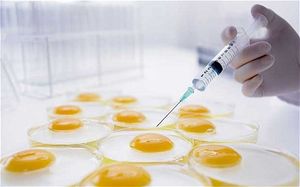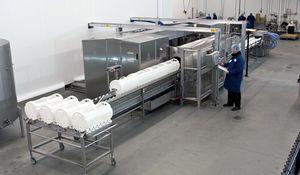The Future of Food Preservation
Introduction
Importance of Food Preservation:
The evolution of, and continuous innovation to food preservation techniques over the years has been necessary for subsistence across the globe. Preventing the growth of bacteria, fungi, and other micro-organisms for the sake of storing food can be achieved through many diverse methods. Processes as simple as drying and salting have evolved into more modern techniques such as irradiation and high pressure food preservation. Innovations to preservation practices are instrumental to the agricultural and manufacturing industries, the military, and to an extent, the survival of many developing nations. Increasing the shelf life of food has many obvious benefits –a larger food supply leads to lower prices for consumers and perishable foods become more transportable, to name a few. New preservation technologies are not just working to increase longevity, they are also functioning to sustain the same qualities of the food that make it desirable in the first place. The physical characteristics and chemical composition of the food will no longer be compromised during the preservation process. Studies have indicated that meat products, for example pork and tuna, have the potential to remain edible for seven to eight years (1). With new techniques such as high-pressure processing (HPP) and innovations to packaging materials, meals maintain their same fresh qualities over the course of their stowage.

Common Preservation Techniques
Common food preservation processes used comprehensively in the past, or presently:
Drying, Salting, Pickling, Refrigeration,Freezing, Oxidation, Vacuum packaging, Canning/bottling, Smoking, Sugaring, Preservatives
The earliest documented methods for preserving food are still very much in use today. Whether by natural occurrence, or human-induced, the processes of drying, freezing, and fermenting food have always served as viable solutions. However, these most basic practices have their drawbacks.
Drying and Fermentation
Drying is for the purpose of moderating the amount of water activity to prevent the growth of bacteria by aerobically respiring. Clearly, drying food does not fully prevent contamination, but in addition, the process changes the physical properties of the food. The acidic products that result from fermentation help to kill off contaminating microbes, but similarly to drying, fermentation changes the chemical properties of the food.
Refrigeration and Freezing
Refrigeration and freezing have both played a substantial role in the effort to preserve food. The ability to stunt microbial growth by storing food in inaptly cold environments has been very important to food transportation. However, more persistent microbes will inevitably contaminate frozen or refrigerated food over the course of time.
Canning and Bottling
Canning and bottling remains a very common technique for preservation. Food is cooked, sealed inside of a sterile container, and is boiled to eradicate any lingering bacteria. The process is very efficient, and it can leave the food edible for a few years. Canned food remains susceptible to anaerobic microbial growth, most notably that of Clostridium botulinum.
Preservatives
The use of preservatives in food has expanded a great deal in recent years. There are two forms of food preservatives: antimicrobial preservatives and antioxidants. Antimicrobial preservatives work to break down, and prevent the growth of bacteria and fungi, whereas antioxidants are used to avert the oxidation of the food. Some common antimicrobial preservatives include sulfites, sodium nitrite, and benzoic acid. Antioxidants generally include Butylated hydroxyanisole (BHA), Butylated hydroxytoluene (BHT), andtert-Butyl hydroquinone (TBHQ).
Recent Developments
Irradiation and Chemical Additives:
Some of the future methods of food preservation are irradiation and chemical additives. Although these methods are currently in use, they are expected to expand and develop further. Irradiation of food is the process of exposing food to ionizing radiation. This process can alter the bacteria, microorganism or virus’ DNA, without harming the food. Irradiation is attractive because of its selective targeting. It is already used on non-food items. “The molecular bonds in the microbial DNA are the main targets of the irradiation, but DNA and RNA synthesis, denaturation of enzymes and cell membrane alterations may also be affected”(1). The process of irradiation opens the possibility to process a large number of foods in great quantities, however it can be expensive. The buildings for such a process require specific infrastructure and construction that is both expensive and time consuming. “The Food and Agriculture Organization (FAO), the International Atomic Energy Agency (IAEA), and World Health Organization (WHO) concluded in their report, that any food irradiated up to a maximum dose of 10 kGy is considered safe and wholesome”(1). Essentially three things were concluded in their report: 1. It won’t lead to toxicological changes in the food that will negatively affect our health, 2. The technology won’t increase the microbial risk of the consumer, and 3. Irradiation won’t lead to nutritional losses. However, most consumers are still radiation-phobic despite these positive results. They aren’t willing to buy something that has, in their mind, been radiated and burned to safety. Another process is the addition of chemicals to preserve the freshness of the food. Consumers feel that this is a risk because of the unnatural state the food and their bodies are subjected to. New research has shown that even the most susceptible foods such as a ham and pepperoni sandwiches can be made to last years. In the TIME article, researchers added chemicals to the sandwich to ensure the oxygen, moisture and other moist areas did not spread mold or microorganisms that would harm the freshness or integrity. Lauren Oleksyk , leader of the food-processing, engineering and technology team at the U.S. Department of Defense Combat Feeding Directorate mixed water-absorbing ingredients including glycerol and sorbitol into the filling. They also increased the use of fine, edible polymer films, which are undetectable in the mouth. These were added to combat moisture that would be detrimental to the sandwich as it provides a good breeding ground for microorganisms and bacteria. In addition to the water absorbing ingredients, Oleksky’s team also added oxygen eliminators. It sounds more intimidating than it is; essentially it is the process of adding oxygen-scavenging chemicals. Oxygen increases the possibility of spoilage to the food. By adding these chemicals, it limits the microorganism’s chance to grow and thrive, and also inhibits the sandwich’s ability to change chemically.

What to Expect in the Future
High-Pressure Processing (HPP)
A potentially groundbreaking and safe process of food preservation is high pressure preservation. Dr. V.M. Balasubramaniam, a food engineer from Ohio State University, is developing a process where food is attacked with 100,000 pounds per square inch of pressure (2). In a Discover magazine article, David Freedman explains the process in which High Pressure Processing works. The food is packaged in a plastic bag and then put into the first compartment. That compartment is also filled with water, to help with the pressure. The second compartment is filled with hydraulic fluid, which is used to press the piston between the two compartments. When even more hydraulic fluid is pushed into the second compartment, the piston is pushed up into the first compartment. The water becomes more condensed, and as a result the pressure in the first compartment increases rapidly (2). After only a few minutes, any food can be ready to eat. While every other process we have discussed thus far has had some negative side effects, HPP appears to be the perfect solution. Because no chemicals are added, there is no contamination or taste alteration to the food. The bacteria in the food remain intact; however they die due to the pressure-induced dismantlement of their DNA structure. Almost all foods are able to be pressurized in the machine. The only exception is some veggies and fruits, which get too pulverized. The only major drawback to HPP is simple – the cost. High-pressure machines typically cost $3 million (2). This technology is so new, and therefore companies have not found a cheap and efficient way to mass produce these machines. However, with due time, we expect to see high pressure food preservation machines available to the public at a reasonable cost. This technology is simply too good to reserve for large industrial food processing plants.

Conclusion
In conclusion, food preservation has been pivotal to our society since the beginning. Preservation has come from simple processes such as salting, to more complex preserving methods such as irradiation and chemical additives. Looking into the future, High Pressure Preservation seems to be the next logical step. In an increasingly health-conscious world, an uncontaminated, well preserved food source is the ultimate goal, and hopefully the costs of production will decrease for all of us to enjoy HPP foods.
References
General:
(1) Blum, Deborah. "Food That Lasts Forever." TIME Magazine 12 Mar. 2012. Print.
(2) Freedman, David H. "The Bright, Hi-Tech Future of Food Preservation." Discover Magazine Sept. 2011. Discover Magazine. 2 Sept. 2011. Web. 4 May 2012. <http://discovermagazine.com/2011/sep/17-impatient-futurist-hi-tech-future-food-preservation>.
Edited by Ian Edwards Andrew Belmonte Tim Welch Student of Rachel Larsen
